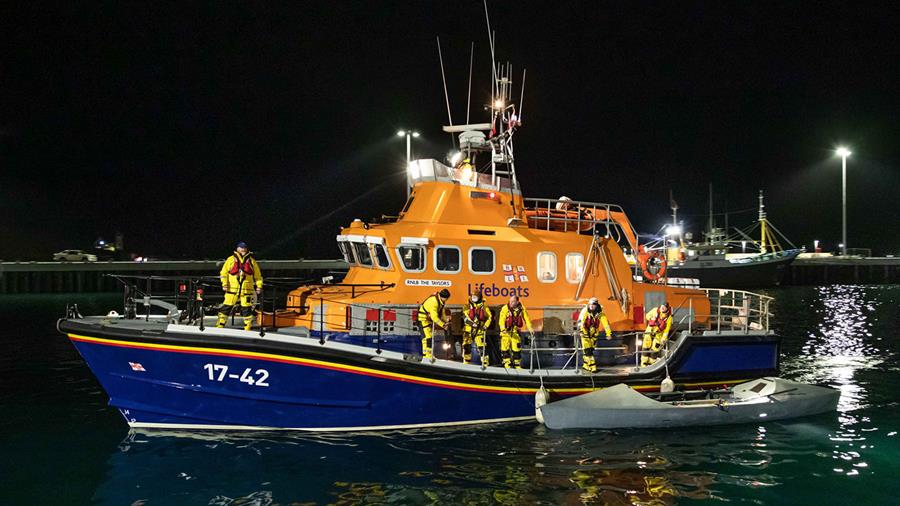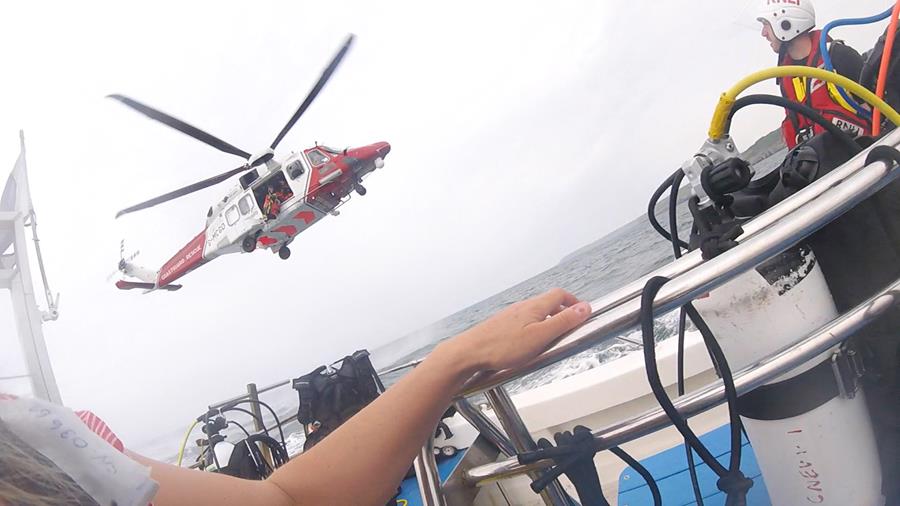
What’s really involved in a tow?
Our lifeboat crews are often called out to stricken boats that need to be towed to safety. This might sound straightforward, but sometimes these are gruellingly long journeys in ferocious weather. So, what does a tow really involve?
A broken rudder and boisterous seas
In August last year, a 10m Dutch yacht found herself in trouble. Her rudder had broken and she was drifting towards the notorious Shingle Bank, just west of the Needles on the Isle of Wight. This is an area renowned for treacherous seas, where the tides of the Solent meet the Channel. And that day, a near gale force wind was gusting. This was swiftly becoming a dangerous situation.
Yarmouth's Severn class lifeboat Eric and Susan Hiscock (Wanderer) launched to help. As the lifeboat powered to the scene, the yacht was getting ever closer to the shingle bank. She anchored, but the violent seas left the yacht spinning around the anchor. This made the lifeboat’s approach dangerous, so the Yarmouth crew asked them to cut it.
The crew could then secure a temporary tow from her bow to pull the yacht clear of the shallows. It was Crew Member Kevin Taylor who threw the line.
‘If you mess it up, and the rope you throw gets tangled or you miss, it takes time to recover – time you don’t have. You need to make sure you get it right first time. Luckily, I did it first time and got it on the right spot. And the man onboard the yacht managed to pull it across,’ he remembers.
Once they reached calmer waters, the lifeboat crew were able to establish a safer tow back to Yarmouth, which they reached 2½ hours after launching.
This tow relied on the skill of the coxswain, who artfully manoeuvred the 42-tonne Severn class lifeboat. Crew Member Robert Scott recalls: ‘He’s reversing against the weather, tide and wind, holding close enough to get a line by hand across to the casualty vessel. It takes a considerable amount of skill and nerve to get that done successfully.’
What are the steps involved in a tow?
The first thing the crew do is decide whether or not they need to tow. To do this, they’ll assess the weather, sea state and water depth. They’ll consider the size and condition of the casualty boat and find out how many people are onboard.
‘The easiest way to bring people back to safety is usually on their own boat,’ says Swanage Coxswain Dave Turnbull. ‘As long as the boat is in good condition – not on fire or sinking – we’ll take it in tow to a place of safety. The last thing you’d want to do is tie yourself to a boat that’s sinking.’
Once they’re fully briefed and prepared, the crew will pass the tow from the lifeboat to the casualty boat.
In some cases, the lifeboat can be manoeuvred alongside the casualty boat, so the crew can hand the tow to the people onboard. Otherwise, the tow rope is thrown. Tow ropes are heavy, so a light line or heaving line can be used to help throw the tow rope across. In some cases, a lifeboat crew member might go onboard the casualty vessel to help set up the tow.
‘We try, where possible, to put a crew member onboard the casualty vessel to rig the tow,’ says Coxswain Dave Turnbull. ‘If it’s howling rough, we might not. We need to weigh that up. The odds of someone getting their fingers trapped are higher if it’s not our crew. You could have the best master mariner in the world on the boat, but you need to know what they’re doing.’
When the tow rope is secured on the casualty boat, it gets paid out to the right length - long enough to allow a dip in the rope. Making sure the length of tow is correct is important, as the right length will reduce chafe, snatching and stress on the rope.
Towing can also place a lot of stress on the boat, so the crew need to make sure the deck fittings can take the loads placed on them. If needed, they can use other strong points such as masts and winches.
‘In an ideal world, the boat would have something nice and low you could attach to,’ says Dave. ‘If you’re pulling from up on deck it pulls the bow of the boat down. If you imagine towing a car, it’d be like towing from the roof!’
In rough weather, the crew will try to tow in step. This is where both boats position themselves on similar parts of different waves, which minimises the strain on the tow rope.
Once the tow is underway, the lifeboat crew regularly check the casualty boat for position and signals from the people onboard, and the tow rope for chafing. ‘You need to monitor both ends regularly,’ says Dave. ‘This is where it’s helpful to have a crew member onboard.’
They may need to adjust the tow rope so that a fresh part of line comes into contact with the fairlead (a hook to tie the tow rope around). This is called freshening the nip and prevents chafing and breaking the rope.
The tow rope breaking or parting under load isn't just inconvenient – it’s dangerous. The recoil could cause serious injury and damage. The crew need to follow strict safety precautions while towing, including keeping clear of the ropes.
Are there different types of tow?
Casualties are usually towed astern (behind) of the lifeboat. But sometimes, like when the boat approaches a harbour, it may be necessary to bring the casualty alongside. To do this, the crew need to shorten the tow. Sometimes this is an easy procedure that can be done in one move, but for a long tow or in difficult conditions, it’s usually done in several quick attempts. The crew need to reduce their speed gradually, and take great care not to foul the propellers with the tow rope.
A challenging tow
Earlier this year, Penlee and Sennen Cove lifeboat crews joined forces to assist a 3,600-tonne coaster, Lady Alida, in an 11-hour rescue.
The 88m cargo ship had suffered engine failure at 3am, three miles south of Gwennap Head. With a strong south-west wind blowing, the ship started to drift towards shore with seven crew members onboard.
Falmouth Coastguard requested the launch of Penlee’s Severn class lifeboat Ivan Ellen and Sennen Cove’s Tamar class lifeboat City of London III. In darkness and a force 6 wind, the lifeboats were able to tow the coaster two miles out into deeper, safer water. The Lady Alida dropped anchor and both lifeboats headed back to Newlyn at 6.20am.
Five minutes later and both crews were having a warming cup of tea in Penlee’s boathouse. But they were interrupted by a call from Falmouth Coastguard requesting the relaunch of both lifeboats. The Lady Alida was dragging its anchor and drifting towards the shore.
Just after 7am, both lifeboats arrived on scene. The plan was to stand by until a tug arrived from Brixham but, one and a half hours later, there was no sign of the tug. The Lady Alida was only 2½ miles from shore and still drifting. So, once again, the Sennen Cove and Penlee lifeboats attached tow ropes and slowly headed seaward for safer waters.
The salvage tug was still struggling in poor weather conditions, so a larger tug anchored in Mount’s Bay was tasked to help the Lady Alida. By the time it arrived, the lifeboats had towed the Lady Alida over 4 miles to safer waters, despite the bad weather working against them. The lifeboats were finally able to stand down at 2pm – 11 hours after first being called out.
Patch Harvey, Coxswain of the Ivan Ellen, says: ‘It was an extremely long job, not made easy by the conditions. A fantastic team effort from both of the volunteer lifeboat crews from Penlee and Sennen Cove.’
Our volunteers take on more challenging tows in Saving Lives at Sea, a 12-part BBC series on the RNLI’s lifesaving work. Get more stories from the series here.
Categories
You may also enjoy the following





